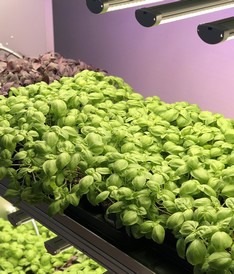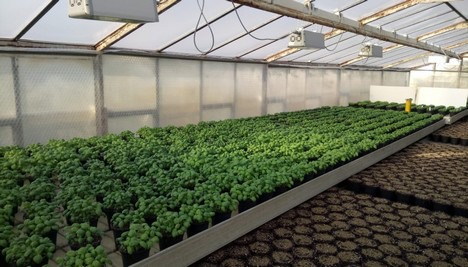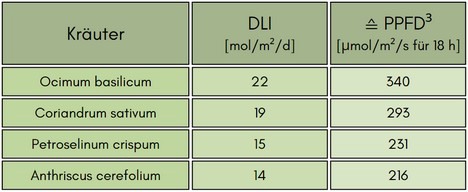Herbs continue to be in vogue. Whether as potted plants for the fresh kitchen, as part of an indoor herb garden or as a feature on people's balconies. Herbs are also used as flowering ornamental plants with the option of further use after flowering. Producing herbs in a way that differentiates them in the growing market also places new demands on sensible assimilation exposure, as herbs are excellent for year-round marketing.
Promoting growth and aroma
The amount  of potted herbs and fresh-cut herbs produced in Germany is continuously increasing, as is buyers' interest in ever new herbs and varieties. Fresh herbs, especially potted ones, have become indispensable in the kitchen. It is therefore all the more important to position oneself on the market as a producing company with exceptional goods and special quality. The herb varieties, which often come from warm climates, not only place high demands on the prevailing climate but their quality can also be controlled by light intensity and spectrum. A significant increase in quality is achieved by the use of modern supplementary lighting with light sums (DLI¹) of 12 to 15 mol/m²/d. This makes it possible to control the aroma of the herbs. Such exposure, which promotes aroma and growth, is possible with FUTURELED's LED exposure systems.
of potted herbs and fresh-cut herbs produced in Germany is continuously increasing, as is buyers' interest in ever new herbs and varieties. Fresh herbs, especially potted ones, have become indispensable in the kitchen. It is therefore all the more important to position oneself on the market as a producing company with exceptional goods and special quality. The herb varieties, which often come from warm climates, not only place high demands on the prevailing climate but their quality can also be controlled by light intensity and spectrum. A significant increase in quality is achieved by the use of modern supplementary lighting with light sums (DLI¹) of 12 to 15 mol/m²/d. This makes it possible to control the aroma of the herbs. Such exposure, which promotes aroma and growth, is possible with FUTURELED's LED exposure systems.
Control of fungal diseases
Fungal diseases play a special role in herb production, as they can quickly lead to a complete loss of production. FUTURELED was the first company in the world to develop a light-based solution that allows proactive containment of fungal spores on and in plant stands without the need to use fungicides. Correct lighting is key! This allows fungal spores and other pathogens to be controlled sustainably without restricting the plants' growth.
Used regularly, FUTURELED SporeCleaner can reduce the number of germs in the crop below a harmful level and thus prevent an outbreak in the crop. Even after an outbreak, after removing the diseased plants, the system can be used to disinfect the plants and reduce the germ pressure to a minimum. This way, a further infection can be effectively prevented. The use of the SporeCleaner is harmless to the environment and can be carried out in the greenhouse without hesitation.

The light sums to be achieved
In herb culture, compact growth and a convincing aroma are important characteristics that are hard to achieve without the right lighting. During spring and winter, in particular, fresh potted herbs are in demand in larger quantities. So early in the year, the right assimilation exposure makes all the difference. In principle, many herbs can be cultivated without assimilation exposure, but the quality drops sharply. Thus, 7 mol/m²/d can be defined as the minimum lower limit of the light sum.
For many herbs, the light sum has a much stronger influence on quality than the prevailing temperature or fertilization. Light sum control-oriented to PAR² radiation has a direct influence on the quality of the herbs produced. Another advantage of production under sufficient light sums is the increased vitality and stress tolerance of the herbs.

LED lighting systems in use
The right light sum makes all the difference when it comes to herbs, helping to promote both high qualities and quantitative production in equal measure. Under optimal light sums, greater shoot axis strength and compactness are achieved, and significantly improved aroma is also recorded. At the same time, vitality is promoted and stress tolerance is improved. The latter is particularly important for the production of organic pot herbs.
If perennial or woody herbs such as Lavandula angustifolia (lavender), Artemisia dracunculus (tarragon), and Rosmarinus officinalis (rosemary) are also cultivated, assimilation exposure has a particularly positive effect on growth and aroma, as our studies in cooperation with the Julius Kühn Institute have shown. In addition to significantly increased growth of up to 150% compared to conventional exposure, the value-giving ingredients were also significantly increased.
For more information:
futureled.de
